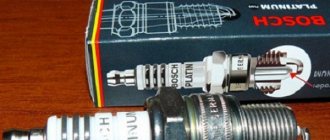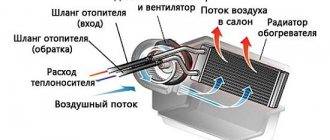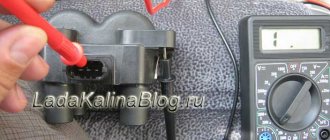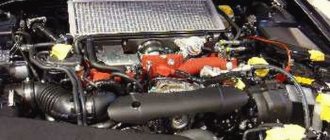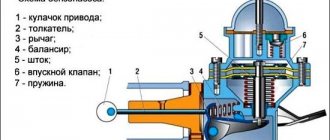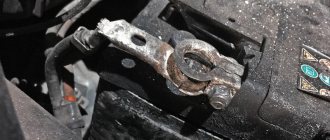January 22, 2020 The working part of the spark plug is constantly in the combustion zone of the fuel mixture and can serve as an indicator of processes occurring inside the cylinder. Whatever plaque covers the surface of the combustion chamber, which is invisible from the outside, is deposited on the electrodes. A car enthusiast with many years of experience, accustomed to repairing a car on his own, can easily identify the problem by looking at the color of the spark plugs. This is the fastest and most convenient way to look inside the engine; you just need to disconnect the high-voltage wire and unscrew the part from the socket.
What color is considered normal?
The performance of the gasoline power unit is indicated by spark plug electrodes painted in a light brown tint, without oil deposits and soot. A similar picture is observed in completely new engines and engines that have undergone a major overhaul.
If the color of the working part differs from the specified one, it is advisable to carry out further diagnostics and identify the cause of the problem. Moreover, the engine itself is not always the culprit. What color options are there for spark electrodes:
- light gray or white;
- black;
- brick or frankly red tint.
In addition to all sorts of colors, the candle skirt is covered with various deposits - soot, brown soot, or may simply look wet. These phenomena are also considered signs of various malfunctions. It is proposed to consider each situation in more detail.
Light electrodes
White or light gray spark plugs in all cylinders are a sign of a lean air-fuel mixture supplied by the injector or carburetor. Moreover, the skirt, area near the electrodes and the threaded part are absolutely dry, without traces of oil.
Why is the fuel mixture supplied lean?
- lambda - the probe incorrectly informs the control unit about the amount of oxygen in the exhaust gases, the reason is sensor wear;
- faulty or clogged nozzles;
- incorrect carburetor settings or clogged fuel jets;
- insufficient pressure in the injector fuel rail;
- problems with the idle air control;
- air leakage under the manifold or in another place;
- unsuccessful chip tuning of the controller made by the owner of the car.
A lean mixture does not pose any particular danger to a running engine, but it does cause discomfort to the driver. The car accelerates slowly, pulls poorly and jerks - there is a lack of fuel. Oddly enough, the phenomenon causes increased gasoline consumption - a car enthusiast who wants to achieve better performance indicators presses the accelerator pedal harder and more often.
Note. Often the light shade of the working electrodes is explained by the type of fuel used. If the car is operated on methane or liquefied gas (propane-butane mixture), this color is considered normal.
Causes of deposits
It is impossible to determine them completely by the type of candle. This is just a reason for the appearance of a working version, which will then need to be confirmed by instrumental diagnostics or other repair methods.
Rich mixture
For combustion without residue, the mixture must meet certain limits in terms of the ratio of oxygen and gasoline vapors in it. And not only in steady, stationary mode, but also in transient modes, that is, during acceleration, warming up, engine braking, idle and power modes. There may be not enough oxygen or there may be a slight excess, but in any case, during normal engine operation, the spark plugs should not turn black. The appearance of black soot on the spark plugs indicates incomplete combustion of fuel, which means either too much of it is supplied, or there are difficulties in supplying the required amount of air.
The reasons for abnormal over-enrichment of the mixture can be very diverse:
- overflow nozzle or misregulated carburetor metering system;
- air filter clogged with dust;
- incorrect operation of sensors or oxygen feedback of the engine management system;
- abnormal pressure in the fuel rail;
- the consequences of illiterate tuning when trying to get an increase in power by simply enriching the mixture.
In this case, the candle will be evenly covered with a velvety black coating of classic soot, most reminiscent of uncleaned stove heating chimneys. And since pure carbon is an excellent conductor of electricity, the energy of the spark will flow through this graphite, and the ignition will stop.
Poor self-cleaning
The candle must be in thermal balance mode, that is, have a temperature of the insulator and electrodes at which the soot that falls on them burns out in the presence of oxygen. If the temperature is insufficient, then even the presence of an oxidizing agent will not help. This happens if the engine is loaded without allowing it to warm up. In power mode, the mixture is enriched, carbon particles are released, fall on the candle, and do not have time to burn out. If you do not allow sparking to occur, then eventually the temperature will rise and the excess soot will successfully burn.
But it is quite possible that the interruptions will begin earlier, the temperature will drop even more, the spark plug will fail, and the owner will be presented with black spark plugs, the reason for which is similar to the previous case.
Heat number discrepancy (CN)
It is the CN that determines the operating temperature of the spark plug, being responsible for both its anti-knock properties and self-cleaning. This number cannot be increased, since too hot electrodes will become a source of abnormal combustion, and it is undesirable to lower it due to the tendency of the spark plug to be filled with hydrocarbons. Therefore, the CV is very carefully selected for each specific engine on stands and is indicated in the form of a recommended type of spark plug or its analogues with the same properties. Ignoring these requirements is fraught with problems, even destruction of the engine. Well, a spark plug that is simply “cold” for a given engine will quickly become covered with unburned carbon. Sometimes completely, and sometimes - separately the electrodes or only the upper part of the insulator. It is always colder because it is in contact with the body and is located further from the combustion source.
Misfires
They do not always depend on the candle. This could be a half-dead ignition coil, high-voltage wires with leaks, weak pulse parameters in terms of voltage and rising edge, and so on, there are a lot of reasons. Ideally diagnosed with an oscilloscope, although there are simpler methods. In any case, the spark plug will cool down, which will reduce the situation to the one described above.
In fact, the ignition system alone cannot be blamed for misfires. As popular wisdom says, there is either nothing to burn, or nothing to set on fire. And you can also add mechanical problems. Diagnostics to help. And the control system computer can provide data on the number of cylinder misfires; it constantly and diligently counts them, typing giant multi-digit numbers in the event of a malfunction.
The working part is covered with black soot
Black spark plugs are a symptom indicating that the fuel mixture is too rich (the proportion of gasoline is increased above normal). Therefore, the fuel does not burn completely and forms a layer of soot on the chamber walls and spark plug electrodes.
An additional sign of this problem is black or dark gray smoke from the exhaust. When over-gassing, small flakes of soot may fly out of the pipe.
There are quite a few reasons for the enrichment of the air-fuel mixture, the most common ones look like this:
- One of the key sensors has become unusable - air flow, temperature, throttle position or oxygen content in the exhaust (lambda probe). The controller activates the emergency program and prepares the mixture according to other indications.
- Carburetor malfunctions (clogged air jets, worn throttle valves, etc.).
- Failure of the pressure regulator in the fuel line.
- Wear of nozzles - nozzles “overflow” and leak when the power unit is not working.
- Problems with sparking - the power of the electrical pulse is not enough to ignite the combustible mixture normally.
Important! If during the diagnostic process you find black spark plugs, the fault should be found immediately. Increased gasoline consumption is only part of the consequences of excessive enrichment.
There are others, not so harmless:
- some of the unburned fuel penetrates the crankcase and dilutes the oil, accelerating the wear of engine parts;
- the other part gets into the exhaust manifold, which is why shots are periodically heard in it;
- soot clogs the expensive catalytic converter - it has to be cleaned or replaced with a new one;
- The service life of the spark plugs is sharply reduced.
When running on a rich fuel mixture, the engine “chokes”, unstable idling and skipped cycles are observed. When a certain amount of soot heated to a high temperature accumulates in the chambers, a “pseudo-diesel” effect occurs - after turning off the ignition, the engine does not want to stall and makes 2-10 crankshaft revolutions. The reason is hot soot, igniting the combustible mixture without a spark.
Origin of red plaque
This phenomenon is less common than the effects described above. Why are there red electrodes on some spark plugs?
- the tank is filled with low quality gasoline with additives that increase the octane number;
- a car enthusiast or a fuel supplier adds additives to gasoline, which contain a large amount of metals;
- the owner of the car installed spark plugs in the cylinders that did not match the heat rating.
The reasons for the reddish tint of spark plugs do not pose a direct threat to the power unit, but are harmful in the long term. Driving on low-quality gasoline with unknown additives a priori accelerates the wear of parts and components. Plus an increase in consumption arising from worsening combustion conditions of the mixture in the cylinders.
Operating a car with spark plugs that are “cooler” or “hotter” in terms of heat rating reduces engine power and significantly shortens the life of the elements. A characteristic sign of incorrectly selected spark plugs is a drop in crankshaft speed at idle and missed ignition cycles.
Other signs of trouble
The following symptoms, which you can identify after unscrewing the spark plugs, will tell you about future and current problems with the engine:
- Motor oil can be seen on the threaded tip and area near the outer electrode.
- The working part protruding into the combustion chamber is covered with fluffy brown soot.
- The candle is frankly wet, and there is a strong smell of gasoline.
- The internal electrode is burnt or missing.
When there is a small amount of liquid oil on the spark plug, you should think about checking the cylinder-piston group. The lubricant penetrates through the oil scraper rings, entering the chamber with each cycle and upward movement of the piston, so it does not burn. As a rule, such an effect indicates the initial stage of wear of the compression and oil scraper rings.
The light brown color of the coating means that the engine consumes a large amount of lubricant due to waste. Moreover, the oil penetrates along with the combustible mixture through the opening valves. The fact is confirmed by the fact that the lubricant completely burns out and is deposited on the walls, since it enters the chamber only during the intake cycle. The reason is critical wear of the oil seals (otherwise known as valve seals). An additional sign is high oil consumption, amounting to 0.5–1 liters per 1 thousand kilometers.
A wet spark plug that smells of gasoline was probably unscrewed from a non-functioning cylinder. The second option is complete failure of the spark plug itself. Gasoline is regularly supplied into the chamber by an injector, but does not ignite and partially flows into the crankcase. If there is no compression in the cylinder, then compression and subsequent flash do not occur - fuel is wasted (consumption reaches + 25%) and dilutes the engine lubricant.
Reference. An idle cylinder is clearly audible at any engine speed - the engine desperately “troubles” and has difficulty starting when cold.
Obviously, a spark plug with a burnt-out electrode must be replaced. An important nuance: these parts are not replaced one at a time, but only in sets of 4 pieces. It is allowed to place a working spark plug in the cylinder temporarily - to get to the garage or service station.
An engine, like any other mechanism, can begin to malfunction. And spark plugs can serve as a kind of indicator of the condition of the engine. But not every car enthusiast knows what the readings of this indicator mean. In this article we will tell the reader what white deposits on spark plugs mean and how to get rid of it.
How to diagnose engine performance by the color of the spark plugs?
The working part of the spark plug is constantly in the combustion zone of the fuel mixture and can serve as an indicator of the processes occurring inside the cylinder. Whatever plaque covers the surface of the combustion chamber, which is invisible from the outside, is deposited on the electrodes. A car enthusiast with many years of experience, accustomed to repairing a car on his own, can easily identify the problem by looking at the color of the spark plugs. This is the fastest and most convenient way to look inside the engine; you just need to disconnect the high-voltage wire and unscrew the part from the socket.
Remedies for injector and carburetor cars
- If plaque occurs due to a lean fuel mixture, the culprit is poor quality gasoline. The solution is obvious: you should refuel elsewhere.
- If carbon deposits on the spark plugs appear due to early ignition, then the problem is solved by reducing the ignition timing.
- Finally, if plaque occurs due to a low heat rating of the spark plugs, you should replace them with new ones, having first checked the correct heat rating in the car’s operating instructions.
As you can see from this article, getting rid of white deposits on spark plugs is quite simple. But you should not delay in fixing this problem, since it often indicates systematic overheating of the engine combustion chamber. Overheating leads to burnout of engine valves. And repairing valves is expensive.
Experienced drivers and mechanics know that a pulled spark plug can be a good diagnostician in determining the condition of the engine and ignition system! In a normally running engine
varies
from light gray to light brown
. If the color in your car’s engine is not the color it should be, then watch the video and take into account the diagnostic findings of a professional.
To obtain reliable data on carbon deposits on spark plugs, carry out an inspection after the engine has been running for a long time, and not only at low speeds, otherwise you can draw erroneous conclusions.
When should you check spark plugs?
Most often, we start checking the functioning of the spark plugs only when problems with the engine are obvious. But this is completely wrong. It is necessary to check the condition of the spark plugs after covering every 5–7 thousand kilometers and immediately before going on a long trip. The ease of eliminating the cause that led to the formation of carbon deposits on the spark plugs also depends on how quickly you detect the presence of a problem. By the way, if you replace old spark plugs with new ones, you need to check their performance after you have driven 200 kilometers.
Quite common are cases when, when starting a car engine at sub-zero air temperatures, a motorist hears the engine revving. It is completely logical that the owner of the vehicle immediately turns off the engine and hurries to unscrew the spark plugs. During their initial inspection, a black coating is discovered, which occurs due to the fact that the machine is used on a frosty day, and the supplied enriched working mixture simply does not have time to evaporate. The cause of the malfunction in this case can be anything, even a broken high-voltage wire.
But what kind of soot should be on the spark plugs for this to be the norm and not a deviation? In principle, in order to determine the presence of a breakdown, no special education is required; it is enough to just find out which color tells us what. One should not neglect the fact that spark plugs are selected for a car purely individually, based on the markings. If you ignore this rule, be prepared to encounter problems in the piston group and cylinder head.
Spark plug color - what should and could it be?
In order to better navigate by the color of the soot when diagnosing an engine by the color of the soot, and also to choose the right one for your engine and needs, we present a table of color values:
| Spark plug color | Characteristics of soot | Recommendations for elimination |
| Light brown (normal candle color) | This is exactly the color that spark plugs should be if they perform well. Indicates that the thermal characteristics of the selected spark plug are normal, the engine, fuel and ignition systems are operating stably | If soot and deposits are minimal, and electrode burnout is moderate, then the spark plug can be safely returned to the workplace |
| Velvety black with dry soot or glossy black with a wet coating | A typical spark plug in an engine with a rich fuel mixture and increased consumption. This type of soot will smell like gasoline. | If this is in the engine of a carburetor car, then you need to adjust the gasoline supply. In a fuel-injected car, a malfunction in the fuel supply control system can have several causes - a failure of the oxygen sensor, a malfunction of the throttle valve drive, an air flow meter, and even a simply clogged air filter. Read more about the reasons for over-enrichment of the mixture. |
| Deep black with an oily sheen | Oily black slag on the insulator, accompanied by increased oil consumption, indicates that oil has entered the combustion chamber. This may be caused by leaky oil rings, stiff valve stem seals, or worn cylinders and valve guides. Additional examination is required for an accurate diagnosis. | Carry out detailed engine diagnostics and eliminate the underlying fault, then change the spark plugs. |
| Black soot | Carbon formation on candles of a black, suede-like color occurs, as in the previous version, due to the incorrectly determined thermal characteristics of the spark plug for this engine and operating mode - too “cold”. Self-cleaning does not occur. This often happens when the urban cycle is accompanied by low speeds and frequent stops and starts. | If there are no defects on the spark plug, you can restore performance with a good cleaning, but if you don’t change your driving style, the situation will repeat itself, so it’s more advisable to replace the spark plug with a “hotter” one (with a lower glow number). |
| Light gray color | Indicates that the air-fuel mixture is lean. It can occur either due to incorrect dosage or. Driving with such mixture formation increases the load on the engine. And this, in turn, threatens to overheat the combustion chamber and burn out the valves. | Check the ignition timing, there may be a lot of advance. Refuel at another gas station; perhaps you refueled with poor quality fuel. You will find more about the causes of a lean mixture and their elimination. |
| White soot with a grayish tint | If the insulator in soot is white without changing the electrodes, this also indicates a lean mixture, but if the electrodes are melted, it is a glow ignition (the spark plug is too “hot”). | Review the thermal characteristics of the spark plugs or the valves may be stuck (check the gaps). Check how the car behaves when the engine is turned off - the glow ignition will manifest itself in the reluctance of the engine to stall after turning off. The spark plug should be changed, specifying the recommended thermal characteristics. You will find how to choose the right spark plugs for your car. |
| White coating on the electrodes or completely clean and wet | Do not confuse white plaque with carbon deposits of the same color. Indeed, in this case, a pure white sediment will be caused by antifreeze entering the engine cylinder. Plaque on the central and side electrodes will be accompanied by, and the candles themselves will have a sweetish smell. If the cylinder head gasket is broken, the spark plugs will be wet and completely washed out from any carbon deposits. | Replacing the spark plug is not enough; you need to additionally inspect the engine block and eliminate the problem of liquid ingress. Old spark plugs can be restored by cleaning and drying them |
| Dirty white porous deposits | This carbon deposit will smell like a rotten egg (hydrogen sulfide). Lead deposits of dirty white color indicate the use of highly leaded gasoline inherent in anti-knock additives. | If the side and central electrodes are not damaged, then the spark plug can be sandblasted or burned out, after which it can be used again, but the fuel needs to be changed. |
| Red (brick) color | A reddish tint on the insulator indicates that the engine is running on gasoline with lead impurities. Brick-colored deposits impair the formation of a spark, since such deposits are conductive, although an ohmmeter will not detect this during testing. | Definitely change the gas station and replace the spark plugs. The fuel contains an excess of additives containing metal and manganese additives, which are used to increase the octane number. |
| Orange (brown) coating with dry soot | An orange-colored spark plug was formed as a result of detonation during the combustion of gasoline with a low octane number or early ignition. | Operating the engine under such conditions poses a danger not so much to the spark plugs as to the pistons. Change both spark plugs and gas station. It is strictly prohibited to overload the engine using such fuel. |
| Glossy yellow insulator | The yellow glaze on the spark plug insulator is the result of a regularly rapid increase in temperature in the combustion chamber following rapid acceleration. Fans of drag racing can often see this color of a spark plug, since a sharp increase in speed is accompanied by a very high temperature in the cylinder due to which all deposits on the surface of the insulator melt, forming an electrically conductive glassy coating. | It is not recommended to drive on such spark plugs, since, since the coating is conductive, sparking failures occur (in particular at high speeds). Therefore, spark plugs whose insulator surface is glossy and yellowish in color must be replaced. |
Take all these points into account and do not operate the car with poorly functioning spark plugs, because they can cause not only unstable engine operation, but even wear of the piston (if destroyed), high-voltage wires or ignition coil (since increased breakdown voltage occurs between the electrodes). And the color of the spark plugs will be an excellent clue about the condition of your car's engine.
Sooner or later, any driver begins to wonder whether his “iron horse” is good. A visit to a service center, where it is possible to diagnose the engine using computer programs, or measure the compression level, can help to understand this situation, but both of these methods, like other technologies in this area, require sophisticated equipment and a good specialist. Naturally, this work is usually quite expensive. In order to avoid unnecessary expenses, you can first try to check the operation of the motor yourself. A careful inspection of the spark plugs will help us with this, namely the carbon deposits on them that have formed during the use of the car.
Causes of carbon deposits on spark plugs.
Soot on spark plugs will help an experienced motorist quite clearly determine what is wrong with the operation of his car. Low-quality fuel, interruptions in carburetor operation, disturbances in the cylinder-piston system, and many other problems will leave their mark on the ignition elements. To notice violations, the car owner will only need to conduct a careful inspection of the engine protection system and assess the state of the engine’s functioning by the color of the soot.
Spark plug. Engine diagnostics using spark plugs
The appearance of a spark plug can tell a lot about the condition of the engine and the processes occurring in the combustion chamber. For this reason, the condition of the spark plugs is one of the important parameters for diagnosis.
A serviceable and normally functioning spark plug has a light gray or light brown insulator heat cone. We can assume that the thermal characteristics of such a candle, that is, its heat rating corresponds to its operating mode.
This candle does not require any intervention or replacement.
On the other hand, the normal color of the heat cone does not always mean that everything is in order with the candle. If, with a normal insulator color, the edges of the central and side electrodes are rounded, and the gap between the electrodes is larger than normal, then this indicates erosive wear of the spark plug, as a result of its long-term operation and the need to replace it.
Black deposits on spark plugs
Often problems with spark plugs are associated with the use of low-quality and contaminated fuel. In this case, you can see a wet black coating with the smell of gasoline on the insulator and electrodes of the spark plug.
This indicates that the power system is preparing an excessively rich fuel mixture, at least at some engine operating conditions. For this reason, the fuel does not burn completely, and its residues in the form of soot are deposited on the spark plug and other engine parts.
Another reason for the appearance of black deposits on a spark plug may be improper operation of the ignition system, or the use of a spark plug with an inappropriate heat rating for a given engine, that is, a too “cold” spark plug, due to which the electrodes cannot self-clean because they do not heat up to the self-cleaning temperature . After cleaning, such a candle is, as a rule, quite suitable for use, and it can be used, if, of course, the causes of plaque formation are first eliminated.
Coked spark plugs
In addition to fuel combustion residues, contamination of spark plugs can be caused by oil entering the combustion chamber. In this case, both the insulator and electrodes of the spark plug can be completely coked with oil residues, and the spark plug will completely lose its functionality.
Oil getting into the engine combustion chamber can be caused by wear of oil control piston rings, valve stem seals, and valve guides. In any case, additional diagnostics will be required to identify the true cause of oil getting into the combustion chamber.
If the spark plug is only slightly contaminated with oil, it can be cleaned, for example, with a brush with copper wire, rinsed in gasoline, dried and reinstalled. In case of severe contamination, it is best to replace the spark plug.
White deposits on spark plugs
When glow ignition occurs, the spark plug insulator is white, and traces of melting can be seen on its electrodes. This is a consequence of overheating of the spark plug because it is too “hot” or the fuel mixture is lean. It is also possible that the ignition is set too early.
In such cases, the spark plug must be replaced after eliminating possible faults.
Destruction of spark plugs
Sometimes you can observe the destruction of spark plugs when its insulator cracks or chips. This is usually caused by detonation caused by improper ignition timing, or the use of low octane fuel.
Due to detonation, not only the spark plug can be damaged, but also other engine parts, so this is a very dangerous phenomenon. A damaged spark plug must be replaced.
When using leaded gasoline as fuel, porous deposits with an unpleasant odor reminiscent of rotten eggs (hydrogen sulfide) can be noticed on the spark plug electrodes. If the spark plug is not very worn, then after cleaning, for example, with a sandblaster, it can be used again.
Video:
PS Now you can easily diagnose your engine by the appearance of the spark plugs. Good luck!
(1 time, rating: 5.00 out of 5)
avto-i-avto.ru
How to correctly assess the condition of spark plugs
The deposit that forms on the candles can provide fairly accurate information, but the test must be carried out in compliance with a number of rules:
- You can evaluate the plaque only after a run of 150–200 km, always with new or well-cleaned SZ.
- Don’t panic if, during the cold season, you hear slight interruptions in the engine’s operation, and at low speeds the ignition elements become covered with a black coating. This is the result of the fact that at low temperatures the working mixture undergoes mandatory enrichment, which, if the engine is slightly warmed up, will not be able to burn completely. If there are repeated interruptions in the operation of the motor, it is worth paying special attention to the condition of the high-voltage wires.
- When visually diagnosing elements, it is worth remembering that they can self-clean only at high temperatures, which are possible only at high speeds.
Soot coloring
During long-term operation, the SZ cannot be perfectly clean, and many people are interested in what the carbon deposits should be like if the car is in good working order, and why this is not always the case. In a situation where the car engine is absolutely in good working order, when you turn out the spark plug, you can see a brownish coating - from light to dark shades of brown. This indicates that the electrode burned out evenly during the operation of the car. If all auto components operate correctly, the service life of ignition elements usually reaches 30,000 km. Modern models of two and three-electrode spark plugs may not need to be changed twice as long. If, upon inspection, the car owner discovers that the spark plugs have carbon deposits of completely different colors, this means that there are obvious irregularities in the operation of the engine. Let's look at the possible types of soot.
White deposits on spark plugs usually come in several shades, which indicate slightly different problems:
- Grayish tint. This is clear evidence of the use of low-quality fuel. In this case, it is enough to unscrew the SZ and clean it, and they will be ready for further use. An important condition for eliminating the problem will be changing bad gasoline.
- Shiny deposits combined with erosions on the contact electrodes. In this case, you can be firmly sure that the spark plugs are overheating. This situation is often caused by low-quality fuel, incorrectly selected fuel protection, or problems with the cooling system. After eliminating the causes of soot formation, the spark plugs may have to be replaced. In this case, you will need to pay more attention to their thermal characteristics.
- White coating. It should not be confused with carbon deposits. Plaque occurs due to antifreeze entering the engine cylinder. Quite often this process is accompanied by the appearance of white smoke from the exhaust pipe. If you smell the candles, you can feel a pronounced sweetish smell. To eliminate this problem, you will need to eliminate the ingress of antifreeze and only then replace the ignition elements.
As all car enthusiasts note, black soot can be found, perhaps, most often. It may also vary slightly, which indicates breakdowns of various types:
- Velvety black dry soot. Carbon deposits of this type will always be present when using highly enriched fuel and significantly increased gasoline consumption. Such deposits always have the smell of gasoline. If this happened to a car that has a carburetor, then it will be quite simple to adjust the fuel supply system. In the injector version, there may be several reasons why this problem occurred, for example, a problem with the oxygen sensor, a broken throttle valve, or a simple clogged air filter.
- Oily-shiny. Such deposits usually form on the insulator. The car has high oil consumption. Most often, this signals the process of oil entering the combustion chamber. This happens due to severe wear of the valve guides and cylinders, worn oil scraper rings, or due to loss of elasticity of the valve stem seals. This will require the owner of the car to carry out additional diagnostics of the engine and repair the breakdown. Only then should you change the spark plugs.
- Black soot, reminiscent of suede. It appears as a result of an incorrectly selected SV for a given engine. In this case, it will be too “cold” and the self-cleaning process will not occur. Most often this concerns driving around the city at low speed and with frequent stops. After cleaning, the spark plug can be used again, but if driving conditions do not change, you will soon experience the same problems again. The best way out of this situation is to simply choose a suitable candle with a lower heat rating.
If the SZ becomes covered with red soot, and the shade can be completely different, you should first change the station where you most often fill up with gasoline. Such deposits appear only as a result of low-quality fuel. Most often, this problem is observed in cars that fill with 95 or 98 gasoline. Gas station owners, in order to achieve additional profits, add various kinds of cheap additives to 92 gasoline, thereby trying to transfer the fuel to another category. The cheapest additives usually contain various metals, such as lead. During engine operation, metal compounds are deposited on the spark plugs in the form of red soot. This deposit has a high current conductivity, and the spark plug can no longer provide the necessary flash of fuel. In this situation, the car owner will need to not only change the spark plugs, but also be sure to change the permanent refueling location.
Erosion
Quite often, the addition of metal-containing additives to fuel results in erosion at the ends of the electrodes. This is a 100% sign that the spark plugs are no longer suitable for use. Along with replacing the spark plugs, as in the previous case, you will have to change the gas station.
Sometimes on the ignition elements you can see a coating similar to ash, with completely different shades. In this case, you may suspect a breakdown in the system or carburetor. The spark plugs need to be cleaned, if possible, or new ones installed. After a run of 150 km. you need to check the condition of the spark plugs again. If signs of gasoline appear, a trip to a car repair shop to check the carburetor becomes inevitable.
Sometimes you can see yellowish or even green rims on candles. This is also the result of using low quality fuel, which contains lead. Irreversible consequences for the car in such a situation are not expected in the near future, but it is worth considering whether you need to overpay for such quality gasoline or whether it is worth changing the gas station. Replacing spark plugs in this case is highly desirable.
Varieties of black soot
The black color indicates the presence of ordinary soot on the candle, that is, unburned amorphous carbon. It is produced by petroleum products and other organic matter that have failed to oxidize properly.
A more accurate assessment of the situation is determined by both the shades of color and the nature of its distribution over the working part of the candle. The appearance of any belts around the outer part of the insulator, located above the hexagon under the spark plug wrench, is usually not a cause for concern, although many auto repairmen mercilessly reject good spark plugs for this very reason. At the very least, this is not justified.
- Uniformity of carbon deposits. It can be concentrated only on the metal of the electrodes, lie on the insulator on one side, or have a location in the form of a cone going deep into the body. As if revealing the source of its appearance in the form of uneven carbon flow or temperature changes along the insulator.
- External dryness of soot. It may look slightly damp and even have a different smell, for example, a strong smell of gasoline. There should be no gasoline remaining in a properly functioning cylinder.
- Oiliness. The porous carbon structure is easily impregnated with oil, and is often formed from it. There are always oil vapors in the combustion chamber, but normally their amount is negligible, and they burn out instantly.
- “Velvet” type of soot. This indicates its large-pore structure, that is, rapid formation and increase in volume.
- The opposite situation is a dense, even possibly shiny deposit. It accumulates for a long time, is durable and does not have a radical black tint.
- Combination of black with other colors. For example, red or brown.
Such nuances indicate various causes of problems. If you rely on them when diagnosing, you need to make sure that the formations are stable and did not accidentally appear a minute ago. To do this, the engine must at least be warmed up, or better yet, loaded with tens of kilometers of movement at a fairly high speed.
Cleaning the ignition elements
Spark plugs do not always require immediate replacement; sometimes it is necessary to eliminate the possible cause of deposit formation. This procedure can be carried out in two ways:
- Mechanical cleaning method. It consists of using simple sandpaper or a small wire brush. Despite the simplicity of the method, it has a number of disadvantages. With such cleaning, the coating on the SZ electrodes can be damaged, and simple scratches can cause increased accumulation of deposits.
- Chemical method. It is more preferable, especially for removing black deposits. The car enthusiast will need to prepare simple cleaning products, a toothbrush and a rag. The elements need to be soaked for about half an hour and then rinsed well. After drying, the candles can be used again.
conclusions
Analysis of this problem and the experience of motorists suggest that visual diagnosis of spark plugs covered with soot is an excellent method not to miss the onset of problems with the car’s fuel system. You need to not be lazy and inspect these parts from time to time. In addition, do not forget that protective gear has its own service life, and when plaque appears, this is the first thing to check. If necessary, the spark plugs must be replaced and only then proceed with initial engine diagnostics.
The best prices and conditions for the purchase of new cars
Credit 6.5% / Installments / Trade-in / 98% approval / Gifts in the salon
Mas Motors
Soot on a car's spark plugs is an important indicator of adequate engine operation. When the engine starts to “trouble”, this is a clear sign that not everything is in order with the spark plugs. However, even with normal operation of the power unit, carbon deposits on the spark plugs can tell a lot. Read about all this in the material from the Procrossover team.
When the engine is not running at full power, sensitive motorists should, if possible, diagnose their iron friend. Instead of an expensive visit to a service station and computer diagnostics, you can prefer a regular check of spark plugs, carbon deposits on which help to identify problems at an early stage. Even on new spark plugs, carbon deposits appear after 100-150 kilometers. In winter, you really need to check the spark plugs after preheating the engine, or even better, after driving for the same hundred kilometers. Otherwise, you will only see a black residue from the enriched fuel mixture.
Soot color - what does it mean and what to do?
Take a close look at the spark plugs. Their color will help you understand a lot... For example, you will be able to identify problem areas of the car. It is not enough to just replace the problematic element; look deeper and look for the cause. If it is not corrected, the new spark plug will very quickly become unusable. The problem needs to be cut to the root. The first step is to deal with the ignition system. The next step is to look at the candles. Determine what color the resulting plaque is. Highlight:
- black
- red
- white
Each of them indicates the presence of one or another problem.
Black soot
This type of soot occurs for a number of reasons. There are two subspecies:
- Dry;
- Oily.
Black and dry carbon deposits are applied to the spark plug due to an overly enriched mixture. This could have been preceded by:
- Incorrect carburetor operation;
- Air filter clogged;
- High pressure in the fuel rail;
- Little spark energy;
- Weak compression.
If an oily deposit appears, check that the oil does not get into the combustible mixture. Often the reason is trivial - wear of the oil scraper piston rings. Damage to the valve caps can also affect this.
White plaque
This color appears due to a number of reasons. White deposits on spark plugs can have several shades. Slightly ashy appears when the engine runs on low-quality gasoline. To overcome the problem, remove them, wipe them and they are usable again. Well, monitor the quality of gasoline. But the appearance of shiny soot and erosion on the contact electrodes is a sign of the use of overheated spark plugs. This happens due to an unenriched combustible mixture, early ignition, or a malfunction of the cooling system. Overheating is very dangerous for spark plugs, because it leads to cracks and various types of damage. Most often, this situation requires replacement.
Red and brown soot
As for red (sometimes called brown) soot, its appearance indicates the presence of unnecessary components in the fuel. It is also possible that too many additives have been added to the oil. A color like red brick may also appear if the engine has been running on leaded gasoline for a long time. The surface of the insulator is covered with a brown conductive coating, which disrupts the normal formation of sparks.
Fixing the problem is quite simple - clean the system.
The spark plug does not produce a spark if carbon deposits close the gap between the electrodes. This is a standard situation for cars in which the engine is subjected to high loads for a long time. To solve the problem, replace the spark plugs.
Black carbon deposits on spark plugs
Most often, it is black soot that forms on candles, which can be either velvety or oily. The first type of soot indicates a large amount of gasoline in the mixture of fuel and air. The causes of black carbon deposits on spark plugs lie in one of the following problems:
- Incorrect operation of the carburetor (due to a malfunction or poor setting);
- Spark plug malfunction (produces a weak spark or does not produce a spark at all);
- Problems with the enrichment agent;
- Clogged air filter (due to which there is not enough oxygen in the fuel and it does not burn completely);
- Excessive fuel injection (due to excess rail pressure or regulator malfunction);
- Weak compression in one or more cylinders.
Black oily deposits occur when a large amount of oil gets into the fuel. There are two reasons for this: faulty valve caps or worn piston oil rings. Remains of the fuel mixture and metal fragments will tell you about even more serious troubles - an indicator that the engine cylinder has completely failed (the partition between the piston rings or the valve itself is destroyed). In this case, the engine will operate with increased fuel consumption, and constant detonation of the mixture will gradually lead to increasingly dire consequences.
We understand the causes of red plaque
You can often find a reddish-brick tint on the incendiary element. This sediment appears due to the fault of gas stations, which add special additives to gasoline to increase the octane number of the fuel. Such a deposit reduces sparking, which leads to overheating of the engine. You can get rid of red carbon deposits on spark plugs by simply cleaning the element and changing the gas station.
Having understood the main reasons for the appearance of malignant plaque, we are confident that even a novice motorist will be able to analyze and diagnose the engine of his four-wheeled friend. Try not to ignore the car’s behavior and provide it with timely care. This will allow you to identify and eliminate faults in a timely manner without spending significant amounts on serious, expensive repairs.
Spark plug erosion
In addition to plaque on the candles, erosion can also occur. The reason for its appearance lies either in the exhaustion of the life of the candles themselves or in fuel with a large amount of tetraethyl lead. Replace the spark plugs and fuel; after this the problems almost always disappear.
note
On average, spark plugs are designed for 25 thousand kilometers. Even if this resource is not exhausted, it is worth periodically checking the quality of their work for early diagnosis of problems.
In order for the engine to operate stably, the spark plugs need to be cleaned periodically, and this can be done in several ways.
- The most common is mechanical cleaning with a hard nylon or even a toothbrush. You can, of course, use sandpaper, but it is so easy to damage the insulator, and this is fraught with at least increased carbon formation.
- Service stations offer sandblasting of spark plugs, and you can do the same at home (if you have a drill with reverse).
- Cleaning by baking or heating helps if you filled the spark plugs during a cold start. You can calcinate it in different ways: with a gas stove, a blowtorch, an open fire, and so on.
- Cleaning with chemicals is the most varied. Rust removers, vinegar, and even Coca-Cola will come in handy.
- Ultrasonic cleaning is also available at some service stations. True, it costs more, and the efficiency is lower than that of the sandblasting method.

